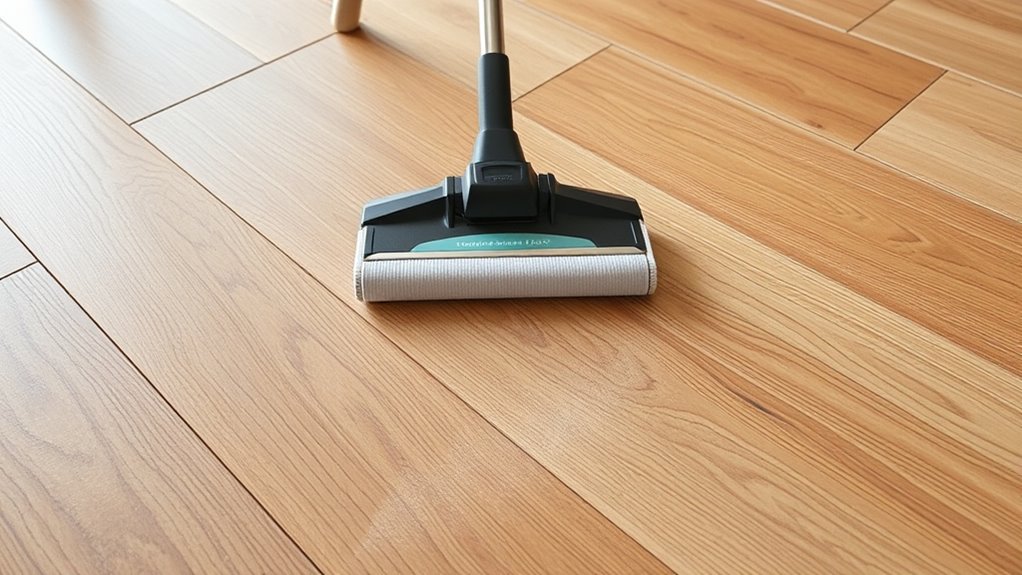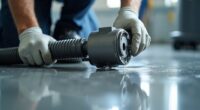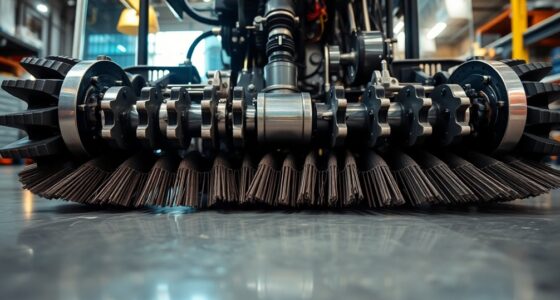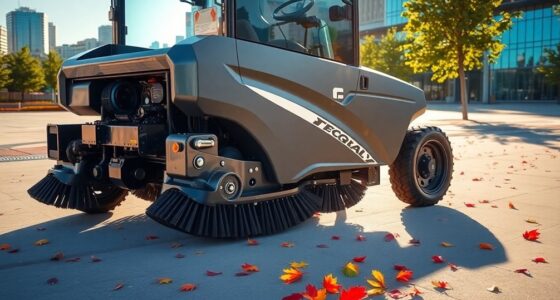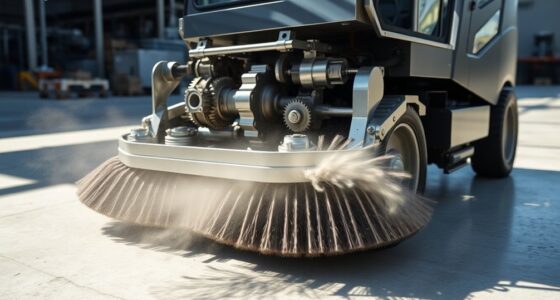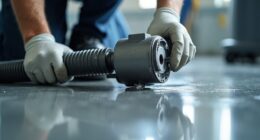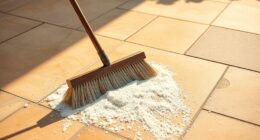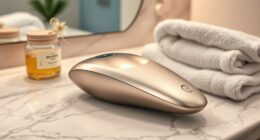For low-moisture scrubbing your wood and LVT floors, use a damp microfiber mop with a pH-neutral cleaner or a specialized wood or vinyl floor cleaner. Avoid excess water and abrasive tools like steel wool or scrub brushes. A soft, circular motion while gently lifting dirt helps preserve surface finishes. Proper moisture control prevents damage and keeps floors looking their best. Keep going to discover more tips for maintaining these floors effectively.
Key Takeaways
- Use a damp microfiber mop with a pH-neutral cleaner for low-moisture cleaning of both wood and LVT floors.
- Avoid excess water; wring mops thoroughly to prevent warping or lifting of the flooring.
- Select cleaning products specifically designed for wood or LVT surfaces, following manufacturer instructions.
- Employ gentle, circular motions during scrubbing to effectively remove dirt without damaging finishes.
- Regularly dust or dry mop before damp cleaning to minimize moisture and maintain floor integrity.
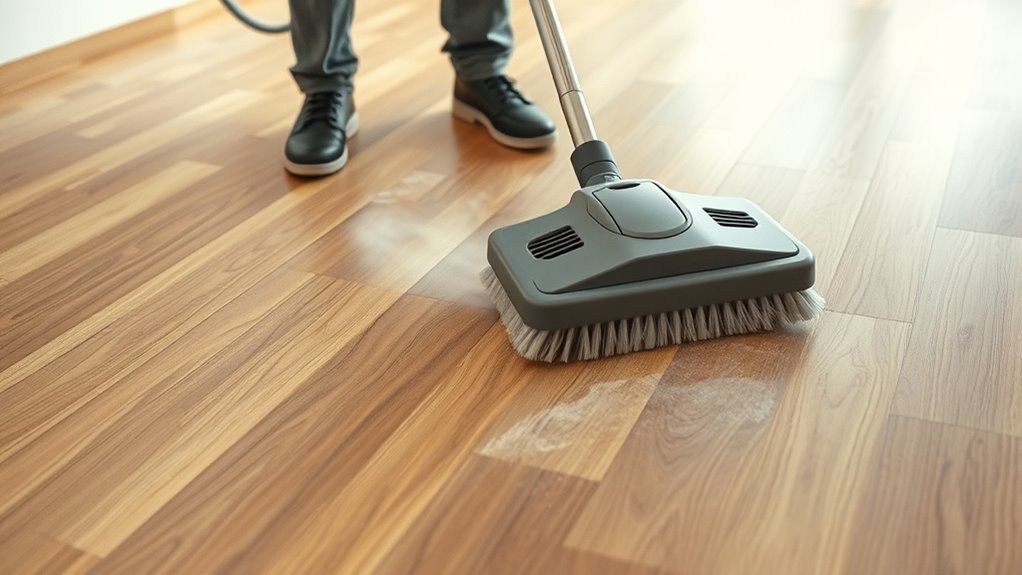
Are you trying to decide between wood and LVT floors for your space? If so, understanding how each flooring type responds to low-moisture scrubbing options can help you make an informed choice. Both options have specific cleaning needs, especially when it comes to dust control and maintaining their appearance over time. Knowing the right cleaning techniques can guarantee your floors stay beautiful and durable without damage or excessive effort.
Choosing between wood and LVT floors depends on how well each responds to gentle, low-moisture cleaning methods.
When it comes to dust control, LVT floors generally excel because their smooth, waterproof surface naturally repels dust and debris. Regular sweeping or dry dusting with a microfiber mop effectively keeps dust from settling into crevices. For wood floors, dust control requires slightly more attention. Using a soft broom or a microfiber cloth helps prevent scratching and keeps dust from building up in grain lines. Both flooring types benefit from frequent dust removal, but LVT’s resistance to moisture makes it easier to keep dust from becoming embedded or stubborn.
Cleaning techniques for low-moisture scrubbing vary between the two materials. For LVT floors, you can often get away with a simple damp mop using a gentle, pH-neutral cleaner. Avoid soaking the floor, as excess moisture can cause the vinyl to lift or warp over time. A well-wrung mop provides enough moisture to lift dirt without compromising the floor’s integrity. For wood floors, it’s vital to use even less water. A damp microfiber mop or cloth with a specialized wood floor cleaner works best. Excess moisture is one of the primary concerns with wood; it can cause warping, swelling, or damage to the finish. In both cases, dry mopping or dusting should be your first step before any damp cleaning. Additionally, understanding the moisture sensitivity of each flooring type can help prevent long-term damage.
In addition to dust control, the cleaning techniques for wood and LVT floors emphasize gentle approaches. For wood floors, avoid abrasive pads or harsh chemical cleaners that can strip the finish. Instead, opt for products specifically designed for wood, and always follow manufacturer instructions. For LVT, steer clear of abrasive scrub brushes or steel wool, which can scratch the surface. A gentle circular motion with a soft mop or cloth is usually enough to lift dirt and maintain the floor’s look.
Maintaining your floors with low-moisture cleaning techniques not only prolongs their lifespan but also keeps them looking their best. Proper dust control combined with careful, appropriate cleaning methods guarantees that you won’t have to deal with costly repairs or refinishing down the line. Whether you choose wood or LVT, understanding these cleaning techniques will help you keep your floors in top shape with minimal effort.
Frequently Asked Questions
Can I Use Steam Mops on Wood or LVT Floors?
You shouldn’t use steam mops on wood or LVT floors because steam cleaning introduces excess moisture that can cause moisture damage. Wood floors are especially vulnerable to warping and swelling, while LVT can loosen or lift if exposed to too much moisture. Instead, opt for low-moisture scrubbing options like damp microfiber mops or specialized cleaning products designed for these surfaces, ensuring you keep your floors safe and well-maintained.
How Often Should I Deep Clean My Wood or LVT Floors?
You should deep clean your wood or LVT floors every 4 to 6 months to maintain proper floor maintenance. Regular cleaning helps prevent dirt buildup and keeps your floors looking their best. Adjust the cleaning frequency based on foot traffic—more frequent cleaning may be necessary for busy areas. Use low-moisture scrubbing methods to protect your floors, and always follow manufacturer guidelines for the best results.
Are Natural Cleaning Solutions Safe for These Flooring Types?
Did you know that eco-friendly cleaning accounts for over 60% of consumers seeking safer home options? Natural cleaning solutions are generally safe for wood and LVT floors, especially when chemical-free options are chosen. They effectively remove dirt without damaging surfaces or exposing you to harmful chemicals. You can confidently use these eco-friendly cleaners, knowing they’re safer for your floors and your family, while also supporting sustainable practices.
What Are Common Mistakes to Avoid During Low-Moisture Cleaning?
You should avoid over-wetting the floor, as excess moisture can cause damage. Use only proper cleaning techniques, like a damp, not soaking, microfiber mop. Don’t use harsh chemicals or abrasive tools that can scratch or dull the surface. Always test cleaning solutions on a small area first. By following these tips, you’ll protect your floors from surface damage and keep them looking their best with low-moisture cleaning.
How Do I Remove Stubborn Stains Without Damaging the Surface?
Did you know that 85% of homeowners struggle with stubborn stains on their floors? To remove tough stains without damage, try gentle stain removal techniques like applying a small amount of vinegar or baking soda mixed with water. Always test a hidden area first. Use surface protection strategies, such as soft cloths and minimal moisture, to prevent scratches or warping while effectively lifting stains.
Conclusion
With each gentle scrub, you breathe new life into your wood or LVT floors, revealing their true beauty beneath the surface. Imagine your space as a canvas, each clean stroke restoring its warmth and shine. Low-moisture scrubbing not only preserves their integrity but also keeps your home’s foundation strong and inviting. So, take this simple step—like tending a garden—and watch your floors flourish, inviting comfort and elegance with every step you take.
